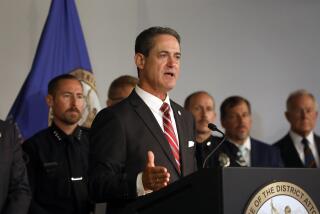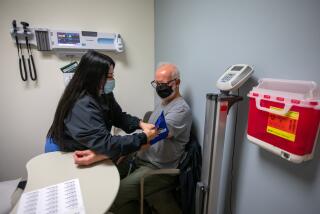Fraud Problem Is Very Real
The man arrived at the emergency department of Cedars-Sinai Medical Center so dangerously short of breath that medical care was the first priority. Questions about insurance coverage had to wait.
As he was stabilized and transferred to an inpatient bed, the man gave hospital personnel his name, date of birth, Social Security number and other personal details so a file could be created. Records showed the man had been treated there before and was covered by insurance.
Or so it seemed.
Three days later, the man--who was actually posing as his brother--was discharged. The fraud came to light after the real subscriber received a statement--referring to a hospital tab for $10,000--from his carrier and challenged it.
Mention health care fraud--a $100-billion-a-year problem in the United States--and most people think of doctors or hospital officials inflating charges or billing for services never performed.
Provider fraud is still the most prevalent type in the health care arena, but it has been on the decline.
Meanwhile, consumer health care fraud is on the rise.
In 1995, 20% of reported health care fraud cases in the United States were blamed on consumers, according to a study released in June by the Health Insurance Assn. of America, a trade group based in Washington, D.C. In 1993, just 7% of reported health care fraud cases involved consumers.
In the same time period, provider fraud declined from 92% of reported cases to 78%.
In 1995, health insurers investigated 5,024 cases of consumer fraud, compared to 1,151 cases in 1993, according to Thomas D. Musco of the HIAA, co-author of the study, “Health Insurers’ Anti-Fraud Programs.”
Some of those cases involved what the HIAA calls “false records of employment and eligibility,” in which consumers borrow cards or obtain insurance information from a covered member and use it as their own, or use a card from an expired plan. Other cases involved falsifying claims and misrepresenting information on applications.
To stem consumer health care fraud, insurance companies and hospitals are stepping up anti-fraud programs. For insurance companies, the effort often involves paying closer attention to claims and record-keeping.
For hospitals, it means focusing more on identification--being sure the person who has arrived for services is indeed the same person named on the insurance card by asking for additional forms of ID, preferably including a photo, and other requests. Going even further, one Indiana hospital relies on a fingerprinting system.
*
While these measures might sound extreme, they begin to make sense after hearing a litany of fraud--and attempted fraud--case histories from physicians, hospital admitting personnel, insurers and fraud investigators. A sampling:
* A man who had dental insurance through his employer filed a claim for a tooth extraction, recalls Jim Garcia of Spectrum Infomatics, a health care anti-fraud consulting firm in Middletown, Conn. Later, he filed a claim for a crown for his son, who was not covered on his plan, pretending it was his crown. The problem was, as an alert insurance company employee discovered, the crown was placed on the same tooth that had been extracted.
* An executive from Springfield, Mass. took his son and his son’s friend--who lacked insurance coverage--skiing. When the son’s friend had an accident on the slopes, the executive took him to an emergency room and passed the friend off as his son.
* A man scheduled for a knee operation told hospital officials during his pre-op visit that his uncle, a well-known pro basketball player, would take care of his bill. When the admitting office called the player’s business office to check, recalls Carl Jackson, health systems manager in admissions at Cedars-Sinai Medical Center, Los Angeles, “they did not know who this person was.”
* A man showed up at the emergency department at White Memorial Medical Center, Los Angeles, with a head injury and Dr. Brian Johnston, chair of the hospital’s department of emergency medicine, ordered X-rays. Medical records showed the man had been a patient before. “I got the [new] X-rays and then looked at the old films,” Johnston recalls. “And then I noticed the [dental] fillings were different.”
*
The dismal lack of insurance coverage partly fuels the increase in consumer health care fraud. In 1994, 6.6 million Californians, or 23% of the population younger than 65, were uninsured, according to statistics gathered by the UCLA Center for Health Policy Research for its publication “The State of Health Insurance in California, 1996.” Included among those uninsured are 1.8 million children--or one in five.
“Sometimes it’s a culture thing,” says Garcia, the fraud consultant. People lucky enough to have insurance tell him they have an obligation to share that coverage with family members or friends.
Whatever the consumer’s motivation, hospitals and insurers are cracking down, trying to be certain the patient is not an impostor.
Probably the highest risk area for consumer fraud is in the emergency room, experts concur, because patients are often brought in without identification or are in dire need of immediate medical attention.
“We ask for ID,” says Lenard Pick, chief development officer and general counsel for St. John’s Health Center, Santa Monica. “Patients also sign conditions of admission.” And that signature can be matched up with signatures on other pieces of identification.
At Cedars-Sinai Medical Center, walk-in patients are asked to provide a picture ID in addition to insurance information, Jackson says. “There is also a series of questions we ask,” such as name, middle initial, Social Security number and many pieces of information that even a best friend would probably not know to discourage impostors.
“We try to do the same for pre-admits,” Jackson says. But the job there is usually easier, he and others say, because there is more time available to check.
At Kaiser Permanente, a second ID is also often requested, spokesman Dan Cano says. The policy has been gradually phased in since 1993, he says, although the “decision to follow the policy” is up to “individual medical centers.”
The policy was put into effect, Kaiser officials say, when it became evident that people receiving care were not always covered members. There were rumors, too, of bogus Kaiser cards being sold on the street for $650 or $700 each.
Other plans rely more on computer systems and less on individual membership cards. “We discourage the use of cards,” says Jeff Album, spokesman for Delta Dental Plans of California, reasoning that it reduces the chance of consumer fraud. For many Delta plans, patients need only tell the dentist their Social Security number and their relationship to the insured, he says. The information is then verified by the dentist with a central computer.
At LaPorte Hospital in Indiana, a fingerprinting system is in place to speed registration but has also helped reduce fraud. The rationale is simple, says Carolyn Shebel, a former court reporter and now information systems manager at the 227-bed hospital. If fingerprinting works well in law enforcement, she asks, why shouldn’t it work for health care? Once a patient has been verified and fingerprinted the first time, it’s difficult for anyone to impersonate him or her.
To register, a patient puts a thumb on a fingerprint scanner of Positive IDentification, a health care version of the ID system made by NEC Technologies for law enforcement agencies. The print appears on a computer screen while a match is searched for. If the patient has registered previously, the patient file can be brought up on the screen.
And what can happen, despite these measures, if consumers are caught in a health care fraud?
“At the very least,” says Cano, of Kaiser, “[personnel] would take the card and call security.” If they had already received services, Cano adds, the police could be called.
Says Pick, of St. John’s Health Center: “We would go after that person for what they owe.”
And, under the Kassebaum-Kennedy health insurance bill signed last year by President Clinton, consumers who intentionally lie on health insurance forms may be prosecuted as federal offenders, be fined and face up to five years in prison.
There could be a hefty personal price as well.
“If you let someone else use your insurance card, their medical history becomes your medical history, and you may have trouble getting coverage later,” notes George Dix, controller at St. John’s Health Center.
(BEGIN TEXT OF INFOBOX / INFOGRAPHIC)
Tips
To reduce the risk of health care fraud, experts suggest:
* Guard your insurance card as you would a credit card.
* Never read your insurance membership number aloud in a public place where someone could overhear and copy it down.
* Maintain a record of health and dental appointments and services.
* Examine any statements received by your insurance carrier to be sure services noted were actually received.
* Report missing or stolen cards immediately to your insurance carrier.
Sources: Lenard Pick, St. John’s Health Center, Santa Monica; Rhonda Seaton, Blue Cross of California; Jeff Album, Delta Dental Plans of California.
More to Read
Inside the business of entertainment
The Wide Shot brings you news, analysis and insights on everything from streaming wars to production — and what it all means for the future.
You may occasionally receive promotional content from the Los Angeles Times.










